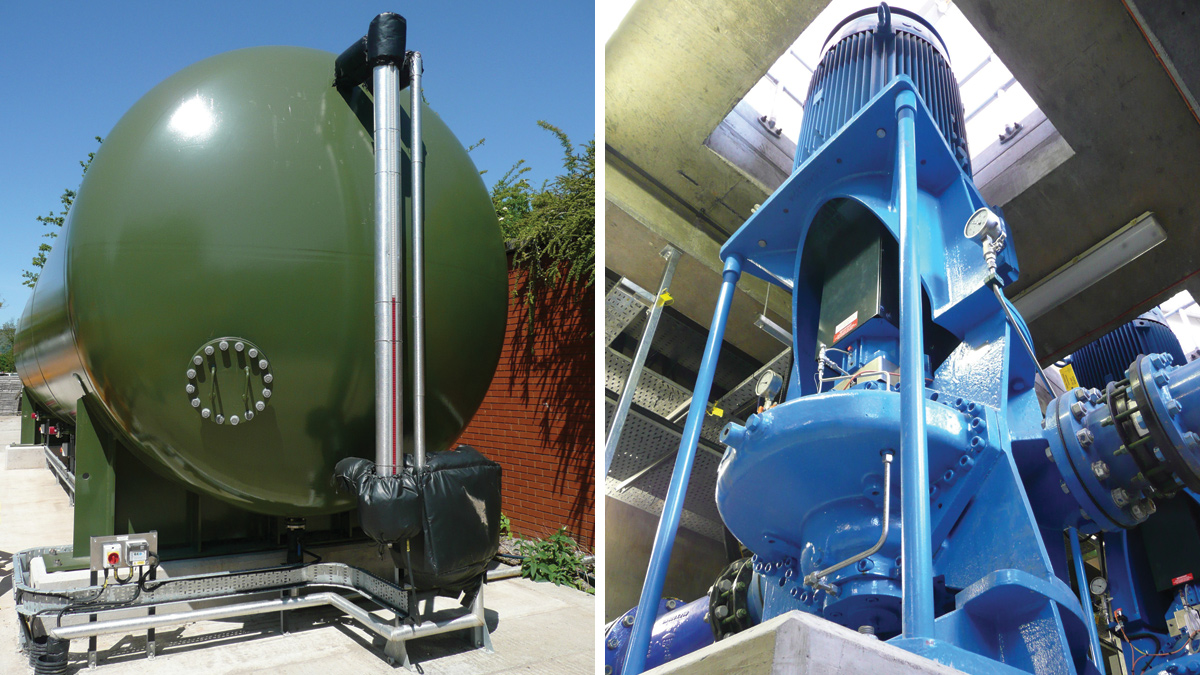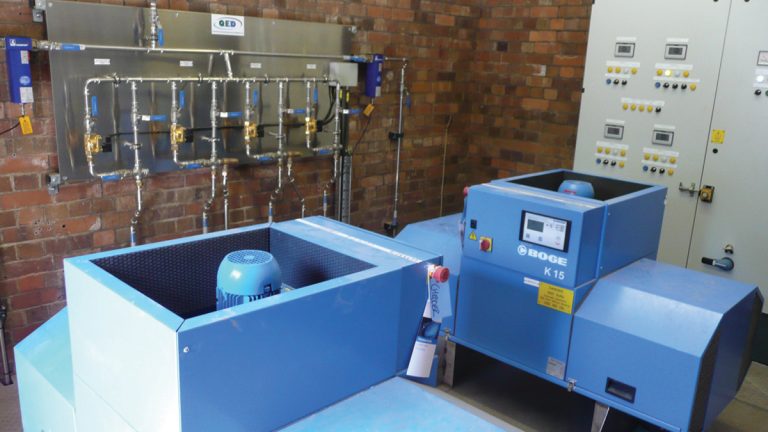Cheddar Pumping Station (2018)

Surge vessel by Quantum Engineering Developments Ltd and one of the 3 (No.) new SPP pumps installed at Cheddar - Courtesy of Bristol Water
The Southern Resilience Scheme is a new £27m water infrastructure project that provides improved security of water supply to a population of approximately 280,000 people across Bristol Water’s supply area. The scheme comprises a new 30km ductile iron main of 600mm and 700mm diameters, as well as the upgrade of the existing pumping station at Cheddar Treatment Works. This included the installation of 3 (No.) new pumps, associated pipework, a new surge protection system, secondary chlorination, electrical upgrade and ICA works. The scheme had a challenging completion date of 31 March 2018 and a total pumping station project value of £2m.
Background
Bristol Water is a supply-only company, serving a population of approximately 1.1m people over a geographical area of around 2400km2, centred on Bristol. The Southern Resilience Scheme was included in the company’s PR14 Business Plan and was approved by the regulator OFWAT for delivery in AMP6. The scheme represents one of the largest projects in Bristol Water’s history.
A key requirement of the scheme was the ability to transfer up to 43 Ml/d of potable water from the pumping station at Cheddar WTW to a service reservoir located at Barrow WTW 20km away.
Cheddar Pumping Station
The Cheddar Pumping Station is sited within the treatment works and consists of three sets of pumps serving the zones of Brent Knoll, Draycottt and Cheddar Cliffs. The Brent Knoll zone is supplied by 3 (No.) variable speed pumps that normally operate in a duty/assist/standby mode to transfer water to Brent Knoll service reservoirs, from which the zone is then supplied. These pumps were originally installed as fixed speed pumps in the early 1990s and more recently converted to variable speed operation with the installation of inverters six years ago.
During outline design, the option to replace and reconfigure the 3 (No.) existing Brent Knoll pumps and motors was identified to achieve the resilience transfer required whilst avoiding the need for a new pumping station building. It also allowed much of the existing pumping station infrastructure at Cheddar to be utilised, including the recently installed inverters. By replacing the existing pumps and motors, operational efficiencies could also be improved.

PRV cross connection between the SRS and Brent Knoll Mains – Courtesy of Bristol Water
New pump configuration
In their installed configuration, the new pumps continue to operate as they did previously in a duty/assist/standby mode with an average duty of 18 Ml/d (208 l/s) at 60m head when pumping to Brent Knoll Reservoirs.
Additionally, they may now also operate as 3 (No.) duty pumps when pumping in resilience mode to achieve the maximum transfer of 43 Ml/d at 146m head to Barrow WTW.
Other works within the pumping station included alterations to the delivery pipework and the installation of new control valves. A new PRV bypass between the SRS main and the Brent Knoll pipework was also installed, allowing supplies to Brent Knoll to be maintained when in resilience pumping mode. A temporary bypass installed during the construction phase allowed the pumps to be replaced in a phased manner and for supplies to be maintained throughout the works without interruption.
Surge suppression
In addition to replacing the pumps, the project included the installation of a new surge suppression system at Cheddar to protect the pumps and pipework from a surge event when pumping in resilience mode. This consisted of a single 100m3 surge vessel (one of the largest installed by Bristol Water) together with duty/standby compressors, associated equipment and controls.

New surge compressors and controls by QED – Courtesy of Bristol Water
The site already had a number of other surge vessels installed, served by an existing set of ageing and inefficient compressors. The surge package included the replacement of these compressors not only to reduce energy costs, but to improve operational efficiency by fully automating surge protection on all zones with a single set of compressors and control panel. The surge package was designed, supplied, installed and commissioned by Quantum Engineering Developments Ltd.
Potable water transfer from Barrow to Cheddar
A further key requirement of the scheme was the ability to transfer up to 29 Ml/d of potable water from Barrow WTW to Cheddar WTW. An existing reservoir and pumping station at Barrow (designed and constructed in AMP4 with the future Southern Resilience Scheme in mind) meant that work at Barrow was limited to pipework connections and associated control works. Up to 12 Ml/d may be delivered into Cheddar by gravity before pumping is required at Barrow, thus avoiding pumping costs at the lower transfer volumes as well as in the normal operating mode of the scheme when resilience transfers are not required.
Given the length of the main and the associated travel time between the two sites, the pumping station project also included the installation of a secondary chlorination system at Cheddar. This consists of an above-ground static mixer housed in a kiosk, associated dosing equipment and controls. The static mixer was supplied by Statiflo and designed to cater for flows up to the maximum transfer into Cheddar of 29 Ml/d. The dosing equipment was installed by Enterprise Pipework Services Ltd.

Static mixer and dosing equipment – Courtesy of Bristol Water
Under normal operating conditions, a minimum bleed flow of circa 1.25 Ml/d into Cheddar is required to keep the new resilience main turned over. This is utilised at Cheddar as wash water for cleaning the existing microstrainers which were, prior to the project, cleaned with wash water taken off the Cheddar Cliff zone pumps. As well as saving the pumping costs, chemical costs are also avoided as secondary chlorination of this bleed water is not required.
At the higher gravity and pump flows into Cheddar, water is taken directly into the service reservoir for onward supply having first been booster-chlorinated. There is also the further option of bypassing the reservoir and taking gravity flow directly in to the Brent Knoll zone to further save pumping costs during power save periods.
Transfer to Banwell Zone
The final key requirement of the scheme is the ability to transfer up to 37 Ml/d into the Banwell Zone that is located between the Barrow and Cheddar sites. This can be achieved by either pumping from the new pumps at Cheddar, or from the existing pumps at Barrow. From the Cheddar Pumping Station, the required transfer can be achieved with two of the three available pumps operating in a duty/duty/standby mode.
Given the challenging completion date of 31 March 2018, the pumps, together with other identified items of plant and equipment with long lead times (including motors and large diameter valves), were procured directly by Bristol Water concurrent with the tendering process for the main contract works.
The procurement of the pumps and motors was based on the WIMES LCC model and resulted in the selection of 3 (No.) identical SPP Pumps Ltd BS08EL vertical split case pumps with an expected efficiency of 83% at the guaranteed duty point for normal operational pumping to Brent Knoll, and 80% for the maximum resilience pumping duty. The pump Factory Acceptance Test (FAT) later demonstrated actual efficiencies of 84.5% and 80% respectively.

Existing inverters and new pump protection control panel. New pumps installed through existing floor openings – Courtesy of Bristol Water
Undertakings
The main contract works for the pumping station was traditionally tendered on a lump sum basis, using the IChemE Red Book Form of Contract, which included amendments to allow for elements of contractor’s design. The contract was subsequently awarded to Kier Services Ltd. Construction work on the pumping station commenced in earnest during July 2017 and was operationally completed on 30 March 2018, following commissioning and performance testing.
Performance testing extended over a period of weeks during March 2018 and included maintaining the maximum resilience transfer flows for a number of hours. Data from these tests also confirmed the accuracy of the original hydraulic modelling work carried out by Bristol Water’s Network Planning team as well as the predicted pump performance.
The outline design of the scheme was carried out by Bristol Water’s Projects team with the detailed design being developed under the main contract by Kier Professional Services. The new electrical switchgear and ICA panel design and installation (including software) was carried out by GPS. External main laying within the site was carried out directly by Kier Services Ltd. Over the course of the construction period for the pumping station, 16,254 man hours were worked by 144 site operatives, representing 12 different subcontractors.

New switchgear panel supplied by GPS – Courtesy of Bristol Water
Cheddar Pumping Station – Table of designers, contractors and suppliers
- Outline design: Bristol Water Projects Team
- Detailed design: Kier Professional Services
- Surge analysis: Black & Veatch (now Binnies)
- Principal contractor, pipe laying, electrical works: Kier Services Ltd
- Diamond drilling/coring: Kier Small Works Construction
- Pumpsets: SPP Pumps Ltd
- Surge Vessels, compressors & control panel: Quantum Engineering Developments Ltd
- MCC Panel, harmonic filter, ICA panel & software: GPS
- Static mixer: Statiflo
- DI pipe: Saint Gobain PAM UK
- Technical Documentation: 3rd Light Media
- Control valves: Cla-Val
- Valves (non-return & gate valves): AVK
- Valves (butterfly valves & actuators): Severn Utilities Valves
- Valves (gate): Industrial Valves
- Flow meters: ABB
- Chlorination/dosing equipment installation: Enterprise Pipework Systems
- Electrical installations: 2K Electrical
- Instrumentation: IFM
- Steelwork fabrication and installation: MJ Patch
- Static mixer & chlorination equipment kiosk: Industrial GRP
- Chlorine analysers: Evoqua Water Technologies
- Water quality instrumentation: Hach Lange
- Standby generator hire: Power Electrics
- Crane hire: Ainscough
Summary
The Cheddar Pumping Station project forms one key element of the Southern Resilience Scheme that now provides resilience of supply to a population of circa 280,000 people, approximately one quarter of the total population served by Bristol Water.
By replacing 3 (No.) pumps within the existing pumping station, rather than constructing a new dedicated pumping station, the required resilience pumped transfers can be achieved whilst providing improved efficiency for normal operating conditions.
By utilising, as wash water for the microstrainers, the minimum gravity bleed flow into Cheddar, pumping costs have been saved as well as chemical costs associated with secondary chlorination that would otherwise be required. Operational efficiencies have been improved by replacing the existing surge vessel compressors and by providing a new automated control system.
The scheme is one of the largest projects in Bristol Water’s history and has been successfully delivered on time providing a great resilience outcome for the company’s customers.










